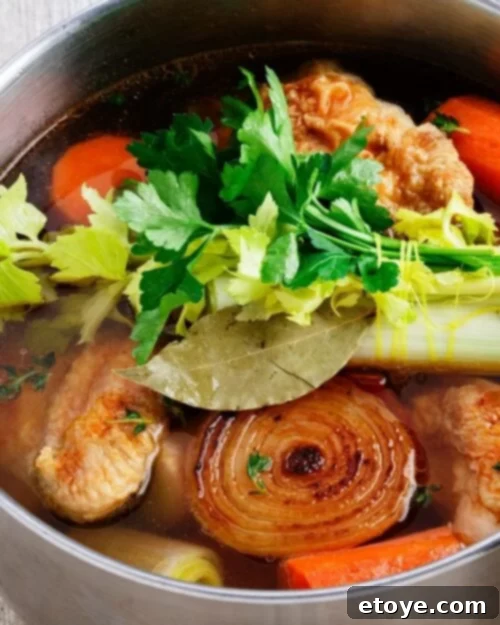Unveiling the Power of Bone Broth: A Comprehensive Guide to Its Benefits and Preparation
Bone broth has garnered significant attention in recent years, evolving from a traditional kitchen staple to a sought-after superfood. This nutrient-rich liquid is meticulously prepared by simmering animal bones – whether from fish, chicken, pork, or beef – for an extended period, often exceeding 24 hours. This prolonged cooking time is crucial, as it facilitates the extraction of a remarkable array of beneficial compounds from the bones, including vital vitamins, abundant collagen, and essential calcium phosphate. These are not just buzzwords; they represent foundational nutrients known for their profound positive impacts on human health. For those keen to start their journey, recipes like slow cooker bone broth offer an excellent starting point for homemade goodness.
While bone broth boasts deep historical roots in various cultures worldwide, its recent surge in popularity has transformed it into a culinary phenomenon. It’s no longer just a humble kitchen preparation; it’s a trend embraced by health enthusiasts and culinary innovators alike. Modern establishments now offer convenient, ready-to-drink bone broth, served in a coffee cup for a quick health boost. The market has responded with an abundance of resources, from dedicated cookbooks that delve into the art of bone broths, such as The Nourished Kitchen Cookbook which prominently features bone broth recipes, to innovative products like bone broth concentrates, designed for ultimate convenience. This widespread availability and recognition underscore bone broth’s transition from niche ingredient to mainstream wellness essential.

Beyond Flavor: Exploring the Impressive Health Benefits of Bone Broth
Bone broth is more than just a flavorful liquid; it’s a nutritional powerhouse renowned for its extensive health benefits. Integrating it into your daily diet can contribute significantly to overall well-being, offering a holistic approach to health. Its rich composition of amino acids, minerals, and collagen makes it a unique elixir with diverse therapeutic properties. Let’s delve deeper into the specific advantages bone broth offers:
- Supports Gut Health and Digestion: Bone broth is rich in gelatin, which converts to collagen when cooked. Collagen contains amino acids like glutamine, known to help maintain the integrity of the gut lining. This can aid in repairing damaged intestinal walls, reducing inflammation, and improving nutrient absorption, making it a powerful ally for those with leaky gut syndrome or digestive issues.
- A Source of Essential Amino Acids: Beyond glutamine, bone broth provides other vital amino acids such as glycine, proline, and arginine. Glycine supports detoxification processes in the liver, aids in wound healing, and promotes restful sleep. Proline is crucial for healthy skin and connective tissue, while arginine is essential for immune function and cell repair.
- Potent Immune Booster: The gelatin, amino acids, and minerals in bone broth work synergistically to bolster the immune system. A healthy gut is intrinsically linked to a strong immune response, and by supporting gut health, bone broth indirectly enhances the body’s ability to ward off infections and illnesses.
- Promotes Anti-Aging Properties: The high concentration of collagen is a significant factor in bone broth’s anti-aging appeal. Collagen is the most abundant protein in the body, providing structure to skin, hair, nails, and connective tissues. Regular consumption can help improve skin elasticity, reduce the appearance of wrinkles, and support youthful vitality.
- Enhances Skin, Hair, and Nails: Directly linked to its collagen content, bone broth is a natural beauty enhancer. Collagen helps rebuild and strengthen skin cells, leading to a smoother, more hydrated complexion. It also contributes to stronger, less brittle nails and promotes healthier hair growth, addressing concerns like thinning hair and lacklustre strands.
- Supports Joint Health: The gelatin found in bone broth contains chondroitin and glucosamine, compounds also present in cartilage, which are vital for joint health. These components can help protect joints, reduce inflammation, and alleviate pain associated with conditions like osteoarthritis, making bone broth a valuable supplement for active individuals and those with joint discomfort.
- Aids in Detoxification: Glycine, an amino acid abundant in bone broth, plays a crucial role in liver detoxification pathways. It helps the liver process toxins more efficiently, promoting the elimination of harmful substances from the body and supporting overall metabolic health.
Unraveling the Distinction: Broth, Bone Broth, and Soups Explained
While often used interchangeably, “broth,” “bone broth,” and “soup” each represent distinct culinary preparations with unique characteristics, cooking times, and nutritional profiles. Understanding these differences is key to appreciating the specific advantages of each, particularly when it comes to the deep nourishment offered by bone broth.
Soups: Generally, soups are complex dishes designed to be a complete meal or a substantial course. They typically combine meats, vegetables, herbs, and often include grains or starches for thickening. The simmering time for soups usually ranges from a couple of hours to a few, just enough to cook the ingredients through and allow flavors to meld. The primary focus of soup is often on the various solid ingredients and a balanced, hearty flavor.
Broths: Broths are lighter liquids, primarily made from simmering meats (or just meat scraps) or vegetables in water, often with minimal aromatics. The goal is a clear, light-colored, and delicately flavored liquid. Broths are usually simmered for a shorter duration, typically 1-3 hours, primarily to extract flavor from the main ingredient without breaking down bones or connective tissues extensively. They serve as an excellent base for other dishes but are not typically consumed on their own for their nutritional density.
Bone Broths: This is where the magic of time comes into play. Bone broths stand apart due to their exceptionally long cooking times, which can extend for a full day, or even longer – up to 72 hours in some traditional preparations. This extended simmering is not merely for flavor; it’s a deliberate process to extract maximum nutrients from the bones, marrow, and connective tissues. The deep, rich flavor profile of bone broth, often seen in a slow-cooked Vietnamese pho broth, is a direct result of this patient extraction. When prepared correctly, bone broth develops a gelatinous texture when chilled, indicative of its high collagen content. You know you’ve extracted maximum nutrients and flavor when the bones become so soft they literally disintegrate with just a little pressure from your fingers, signaling that all their goodness has been released into the liquid.

Make the most of leftover bones and vegetables by transforming them into a nourishing bone broth!
The Art of “Perpetual” Slow Cooker Bone Broth: A Sustainable Approach
Inspired by ingenious methods like those found on Nourished Kitchen, the concept of “perpetual” slow cooker bone broth offers an incredibly sustainable, convenient, and deeply rewarding way to keep a continuous supply of this healthful elixir on hand. This method is perfect for busy individuals or families who wish to integrate bone broth seamlessly into their weekly routine, ensuring a consistent intake of its valuable nutrients.
The process typically begins on a quiet evening, perhaps Sunday night, by loading your slow cooker with bones and water. As you drift off to sleep, the slow cooker performs its magic, gently extracting nutrients overnight. By morning, you’re greeted with a fragrant, nourishing liquid, ready to be enjoyed as part of your breakfast or anytime throughout the day. The beauty of the “perpetual” method lies in its continuous nature: each day, after drawing off some broth for consumption, you simply replenish the pot with more water, and perhaps a few new scraps, allowing the slow cooker to continue its low-and-slow simmer.
As the days progress, this continuous process allows the bone broth to evolve, developing new layers of flavor and richness. You can strategically add fresh vegetables, switch out herbs, or introduce umami-boosting Asian ingredients, tailoring the broth’s profile to your preferences. Over time, the broth becomes smoother, fuller-bodied, and even more concentrated in its beneficial compounds. This method ensures you continuously benefit from the valuable nutrition locked inside the bones, providing a steady supply of collagen, minerals, and amino acids.
Serving this perpetual bone broth is equally versatile. It can be enjoyed simply on its own, perhaps topped with fresh chopped herbs or shredded seaweed for an added boost of flavor and nutrients. For a more substantial meal, consider adding a spoonful of leftover rice directly into your warm bone broth, creating a comforting and incredibly nourishing dish. This perpetual method transforms bone broth preparation from a one-off task into an effortless, ongoing ritual that keeps your body nourished all week long.
Mastering the Craft: Secrets to a Clear and Clean Bone Broth
Achieving a perfectly clear, clean, and deeply flavorful bone broth requires a gentle touch and adherence to a few key principles. The goal is to coax out the maximum flavor and nutrients without introducing cloudiness or an undesirable texture. These secrets are vital for transforming a simple pot of bones and water into a liquid gold standard.
The most crucial aspect is to maintain a slow and gentle simmer throughout the entire cooking process. Avoid vigorous, rolling boils at all costs. High heat and rapid boiling can emulsify fats, break down proteins too quickly, and churn up impurities, resulting in a cloudy, potentially greasy broth. A gentle simmer, characterized by occasional, barely perceptible bubbles, allows the nutrients and flavors to release gradually and cleanly.
Patience is also a virtue when it comes to stirring. Especially after the first day or two of cooking, the bones begin to soften considerably. Stirring the pot too vigorously can cause these softened bones to crumble and disintegrate, introducing fine particulate matter into the broth. This will inevitably lead to a gritty texture and a cloudy appearance, detracting from the desired clarity. Resist the urge to stir and let the slow cooker do its work undisturbed.
To keep small herbs, aromatics, or spices contained and easily removable, employ the use of cheesecloth or reusable herb/tea bags. Items like bay leaves, peppercorns, star anise, or small pieces of ginger can be bundled within these porous materials. This prevents you from having to fish around the pot, potentially disturbing the bones and clouding the broth, while still allowing their flavors to infuse beautifully.
Regular skimming of the surface is another non-negotiable step, particularly during the initial 6-8 hours of cooking. During this critical period, impurities known as “scum” will rise to the surface. This scum is composed of coagulated proteins, rendered fats, microscopic bone fragments (especially if the bones were cut), and other impurities. Failing to remove this scum will cause it to reintegrate back into the broth as it cooks, resulting in a muddy, cloudy, and potentially off-flavored final product. Use a very fine mesh skimmer to gently lift and discard these impurities, ensuring your broth remains pristinely clear.
Finally, consider embracing the concept of “Infinite Bone Broth.” Just as sourdough bakers use a starter to jumpstart a new loaf, you can “seed” your next batch of bone broth with a small amount of concentrated “liquid gold” from your previous batch. This practice, common in restaurants for broths, sauces, and sourdough, imbues the new batch with a rich, complex flavor profile that has already been meticulously built, ensuring an even deeper, more nuanced broth with each subsequent iteration. It’s a testament to the power of continuous flavor development and a truly sustainable kitchen practice.
Elevating Your Broth: Creative Flavoring for Bone Broth
While the inherent flavor of bone broth is delicious on its own, its versatility truly shines when infused with various spices, herbs, and vegetables. By thoughtfully incorporating different aromatics, you can transform a basic bone broth into a culinary base perfect for a myriad of dishes, from hearty stews to delicate noodle soups. Drawing inspiration from global cuisines allows for endless customization and ensures your bone broth always complements your cooking needs.
Many find inspiration in Asian cooking, where broths are foundational elements for iconic dishes like ramen, pho, and dumpling soup. The careful layering of flavors creates a profound depth that is both comforting and invigorating. Let’s explore a few popular Asian-inspired flavor profiles:
Chinese Inspired Bone Broth
For a quintessential Chinese-style bone broth, fish bones are often the preferred choice, imparting a light yet umami-rich flavor. Key aromatics include generous amounts of fresh ginger, which adds a warm, spicy zing and helps to temper any fishiness, along with sliced scallions and plenty of garlic. This combination creates a clean, aromatic broth that is excellent for delicate noodle dishes, congee, or light vegetable soups. Using whole fish frames or heads can maximize flavor extraction.
Thai Inspired Bone Broth
A Thai-inspired bone broth typically utilizes chicken or pork bones, offering a robust base. The distinctive flavors come from a vibrant blend of aromatics: fragrant ginger, bright and citrusy lemongrass (bruised to release its essential oils), fresh cilantro (stems and roots are particularly potent), and a good measure of garlic. Additional elements like kaffir lime leaves or a touch of fish sauce can further enhance the authentic Thai character, making it ideal for Tom Yum or Tom Kha-style soups.
Vietnamese Inspired Bone Broth
Perhaps one of the most celebrated bone broths is the Vietnamese variety, often used for pho. Beef bones are paramount here, and for the deepest flavor, it’s highly recommended to roast them beforehand (e.g., at 350°F for 30 minutes). This caramelizes the bones, intensifying their flavor and color. The magic happens with a carefully balanced blend of whole spices: fragrant star anise, pungent whole cloves, warming cinnamon sticks, earthy coriander seeds, aromatic cardamom pods, and a hint of licorice-like fennel seeds. These spices are often lightly toasted before being added to the broth, maximizing their aromatic impact. This creates a complex, deeply savory broth that is truly unforgettable.

Discover smart ways to utilize your leftover vegetables for an incredibly flavorful bone broth!
Smart Kitchen Hacks: Maximizing Flavor with Leftover Vegetables in Bone Broth
Creating a truly flavorful and nutrient-dense bone broth doesn’t have to be an expensive endeavor; it’s an excellent opportunity for resourcefulness and minimizing food waste. One of the best ways to enhance your broth and give a second life to kitchen scraps is by incorporating leftover vegetables and their peels. This sustainable practice not only adds depth of flavor but also ensures you’re extracting every last bit of goodness from your produce.
My strategy throughout the week involves keeping a dedicated large container in my freezer. As I prepare daily meals, any clean vegetable scraps – peels from onions, carrot ends, celery stalks, fennel fronds, and garlic skins – are promptly tossed into this container. By the end of the week, this collection is typically full, providing a diverse and aromatic assortment ready to be added to my next batch of bone broth. This method is incredibly efficient and contributes significantly to the broth’s complexity.
While most common aromatic vegetables are welcome additions, it’s crucial to be selective, as some vegetables can impart undesirable flavors to your broth. Here’s a list of vegetables that are generally excellent for bone broth:
- Onion (peels and ends)
- Carrots (peels and ends)
- Celery (stalks and leaves)
- Fennel (bulbs and fronds)
- Garlic (cloves and skins)
- Leeks (green parts)
- Parsley (stems)
- Mushrooms (stems or whole, for umami)
- Corn cobs (for a touch of sweetness)
However, it is equally important to avoid certain vegetables that can impart bitter, overpowering, or sulfurous flavors when simmered for extended periods. Make sure you don’t include the following in your bone broth:
- Asparagus
- Broccoli
- Artichokes
- Brussels sprouts
- Cabbage (in large quantities)
- Any other cruciferous vegetables (unless in very small amounts and removed early)
My personal favorites for achieving a balanced, universally appealing broth are celery, onion, carrot, and corn cobs. This classic mirepoix (onion, carrot, celery) forms the aromatic foundation for countless broths and soups, providing a sweet, earthy base that complements almost any bone type.
Choosing Your Foundation: What Bones to Select for the Perfect Bone Broth
The type of bones you choose forms the very foundation of your bone broth, influencing its flavor, texture, and nutritional profile. There’s a wonderful flexibility in bone selection, allowing you to tailor your broth to specific dietary needs, culinary applications, or simply to make use of what you have on hand. This recipe is an ideal way to utilize leftover meat scraps and bones from previous meals, promoting a zero-waste kitchen philosophy. The best bones generally come from grass-fed, pasture-raised, or organic animals, ensuring higher nutrient content and fewer undesirable additives. Here’s a comprehensive guide to selecting the right bones for your next batch of liquid gold:
- Pork Bone Broth: Pork bones yield a rich, often slightly sweet, and very satisfying broth. Excellent choices include spareribs, neck bones, hock bones, or really any substantial pork bones with a good amount of connective tissue. For the best flavor and nutritional density, prioritize bones from grass-fed and organic pork. Pork bone broth serves as a fantastic base for ramen, Vietnamese bun bo hue, or hearty stews.
- Chicken Bone Broth: Chicken bones are perhaps the most popular choice for bone broth due to their mild flavor and versatility. You can use a whole, raw chicken for maximum benefit, or simply the carcass of a rotisserie chicken you’ve already enjoyed. Other excellent options include chicken wings (rich in collagen for a gelatinous broth) or chicken feet (exceptionally high in collagen). Turkey bones also work wonderfully and offer a similar profile. Again, opting for grass-fed and organic poultry ensures a superior broth. This broth is perfect for nearly any application, from sipping on its own to being the base for soups, gravies, and sauces.
- Beef Bone Broth: For a deep, robust, and incredibly savory broth, beef bones are the way to go. Prime cuts for beef bone broth include oxtail (very gelatinous and flavorful), knuckle bones (rich in cartilage), neck bones, and short ribs. While beef bone marrow can add richness, be cautious with excessive amounts, as too much marrow can make the broth taste overly greasy. If using marrow bones, consider spooning out some marrow after roasting and spreading it on bread with sea salt for a delicious treat. Short ribs contribute an amazing depth of flavor and are a personal favorite addition to any beef bone broth. For an even richer, more complex flavor, particularly for Vietnamese bone broth, I highly suggest roasting your beef bones first. Roast them at 350°F (175°C) for 30 minutes before adding them to your slow cooker. This caramelization process is not strictly necessary but will significantly deepen the broth’s color and taste.
- Fish Bone Broth: Fish bone broth offers a lighter, yet profoundly umami-rich and often very quick-cooking alternative. Utilize fish bones and heads (especially from white fish) for this type of broth. This is excellent for traditional Chinese-style broths when paired with garlic, abundant ginger, and green onion. It’s crucial to remove any fish skin and the thin, silvery lining in the gut area, as these can impart an overly “fishy” or bitter taste. For raw fish bones, roasting them at 350°F (175°C) for 20 minutes beforehand can help tame any strong fishiness smell and flavor. Most non-oily fish, such as cod, snapper, or sole, will work well. Avoid oily fish like mackerel or salmon, as they can result in a bitter or overly strong-flavored broth that is less desirable.
